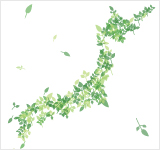2014.03.12 20:31
Third Symposium on Self-supporting Reconstruction "Toward the light" (3/11 2014 at International House of Japan, Tokyo)
The Third Symposium of Self-supporting Reconstruction "Toward the light" was held on March 11, 2014, three years after the earthquake disaster to report our activities. For the first part of the symposium, we asked the guests invited from different areas to speak on several themes. The second part was a panel discussion "Toward the Light" which everyone participated in as we actively took up opinions from the audience.
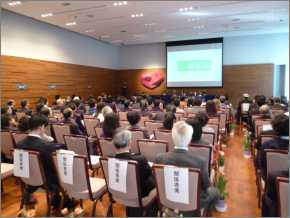
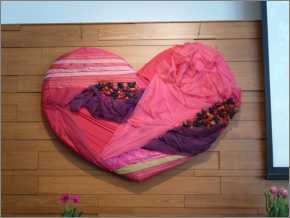
We placed a total of 150 pots of flowers to make the hall into a flower garden. Our Representative Director chose potted flowers and not cut flowers because he wished the audience to reflect on the vitality of and the care for the earth which makes the flowers bloom, as in the song "Flowers Will Bloom". We put up a heart-shaped flower art on the stage wall with the cooperation from U.GOTO FLORIST, Ltd.
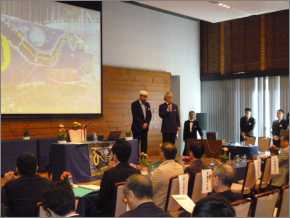
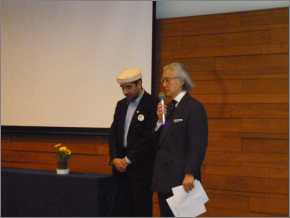
The symposium solemnly began with a silent tribute. We then showed a ten-minute video of the activities of our Foundation, followed by lectures by the guests from Tohoku. It was a good opportunity to share the authentic voices unreported on the media and the understanding of the necessity of self-support (psychological support) which we have focused on since the beginning of our volunteering activities.
We were able to directly listen to the fact that the support required differ from one area to the other although they are collectively referred to as the "affected area", and that it is changing with time. Each of our guests spoke from their own standpoint - the victim, the supporter, and the victim who had to become a supporter.
Each of the lectures is briefly introduced below.
● Lecture 1: Mr. Takahiro Inomata, Executive Director, Minamisanriku Town Council of Social Welfare
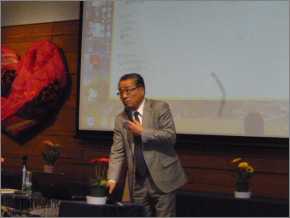
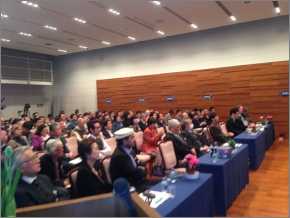
It was explained that if we consider the Great Hanshin-Awaji Earthquake the first NPO/NGO volunteering year, the Great East Japan Earthquake would be the first corporate volunteering year. The required support has changed from sustaining life ⇒ sustaining living ⇒ supporting psychologically. He also referred to the current situation where the administrative staff needs to be the supporters when they are themselves the victims as well.
Aged households with those over 65 years of age are increasing in this area and require sufficient welfare facilities. However, these facilities have been washed away by the tsunami and plans to build new ones to replace them are not yet in sight. A user-friendly welfare complex "welfare mall" was proposed as being necessary to cut down nursing-care insurance.
- The costs required for welfare providers could be cut since they could come together for their operations.
- If the costs of the welfare providers are cut, the nursing-care insurance covered by the users will also be cut down.
- The "welfare mall" would be user-friendly since the users could go there and receive multiple services within a single facility.
- A single user could be supported by multiple welfare providers since they could cooperate with one another.
The road to recovery is yet to be seen in Minamisanrikucho. The awareness on the affected areas will steadily weaken as the memories of the disaster fade away throughout Japan. However, he stressed his wish that the realities and the current situations of these affected areas be understood by as many people as possible and requested a continuous support.
●Lecture 2:
Mr. Masumi Chiba, Chairman, Shiogama City Urato Branch Steering Committee,
Miyagi Prefecture Japan Fisheries Cooperatives
Mr. Mitsuo Utsumii, Chairman, Shiogama City Urato East Branch Steering Committee,
Miyagi Prefecture Japan Fisheries Cooperatives
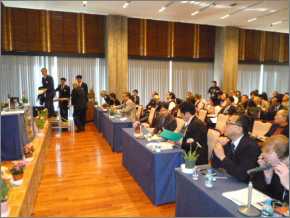
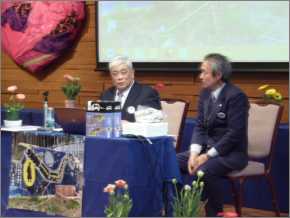
One of the Urato Islands in Miyagi, Katsurashima Island miraculously did not have any casualties. The younger generations played a central role in calling out to evacuate and all the residents were able to reach higher grounds. Most of the residents of this island are fish farmers of oysters and seaweeds, and all the facilities were devastated by the tsunami. The island residents almost gave up restarting their business, but the payment obtained through the tsunami mutual-aid insurance became their hope. Additionally, in order for them to find a path toward reviving their work on their own, they started a private organization "Ura to Uminoko Saisei Project" to raise funds. Our understanding is that they received several million yen at the beginning, but with more exposure through the media, in the end 175 million yen of fund was received.
Our Foundation strongly supported "Ura to Uminoko Saisei Project" to incorporate their business through providing assistance in tax affairs, legal affairs and management. We also provided manpower from mid May through the end of July on every weekend, sending a gross number of more than 50 volunteers assisting with the clerical works, and we all felt thankful when Mr. Chiba repeatedly gave us words of appreciation.
After three years since the disaster, they have been successful in reconstructing their business with remarkable speed, even challenging to farm new types of oysters, and we wish for their continued success in the future.
● Lecture 3: Mr. Junji Suehiro, Director, Asuka no Kai, Senmaya temporary housing complex
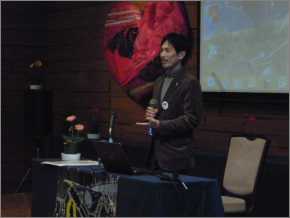
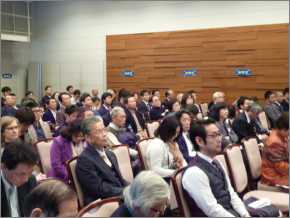
Mr. Suehiro lived near the Kesennuma Bay, and survived by evacuating to higher grounds right after the earthquake. He saw the bottom of Kesennuma Bay with a thundering noise after the earthquake, which was followed by the tsunami washing away houses and 300-ton ships. He could not do anything but to watch his cherished house flow by. It was difficult for him not being able to do anything when his eyes met those of a person in a house flowing past by, eyes as if asking for help. Afterwards, he himself got almost swept away by the water, but was able to help two people, a man and a woman.
He explained that with the support from everyone he has enough food and clothes, but he still has to live in a temporary housing and stressed that he would like to have a place where he could live in peace as soon as possible.
The number of missing and dead in the Kesennuma area is 1,277 (as of January 14, 2014), but as someone who has miraculously survived, he said that he believes the best thing to do to comfort those victims is for him to keep going on forward.
● Lecture 4: Mr. Ikuo Takeyama, Representative, Kamaya Memorial Building Committee
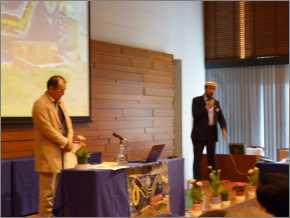
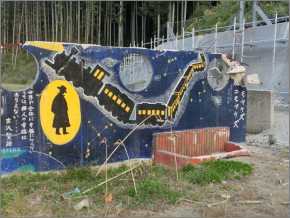
We met Mr. Takeyama when he was preparing to build a memorial at the school ground site of Ishinomaki City Okawa Elementary School on March 11, 2013. Our Foundation also had an idea to dedicate an angel statue at the site, and coincidentally met Mr. Takeyama through our research and we have kept close contact until today.
When the earthquake struck, Mr. Takeyama was away from his family living in Shizuoka due to his work. His mother, wife, and daughter were living in Okawa District. On Saturday, the following day of the earthquake, Mr. Takeyama returned to Ishimaki and started looking for his family believing that they were safe, but he could not find them among those rescued and brought to the evacuation center. He started his search on his own from Monday, but when he saw the open space of land where his house used to stand, he knew he had to realize the fact that his family was gone.
Mr. Takeyama continued the search for six months after the disaster even after he was able to confirm the bodies of his family members. There still are 37 people missing (including 4 elementary school students), and their families are desperately looking for them.
His daughter who was lost in the disaster was all set to join the Japan Air Self-Defense Force from April. Her birthday was March 10th, so he requested the local radio station to play Yumin's song "Hikoukigumo", but unfortunately it did not go on air. He asked if anyone among the audience works in the music industry, he would appreciate it if Yumin's concert could be arranged in Ishinomaki. He has never left his home in order to be with his lost family, but this time, after three years from the disaster, he decided to come to Tokyo believing that his family would be happy if it was to be useful to other people by telling what he experienced.
He concluded by saying that when there is an earthquake, he would like everyone to remember to "focus only on protecting your life", "not go back to get money or things", and "decide where to evacuate and how to communicate beforehand if away from your cherished family."
● Lecture 5: Mr. Yoshihiro Kanno, Manager, Senmaya Branch of Ichinoseki City Hall
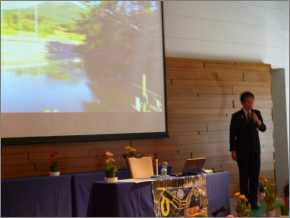
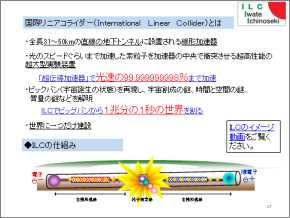
The population of Ichinoseki City Senmaya area has greatly decreased from 180,000 in 1955 to the level of 120,000 people, while it has been aging increasingly. The simulation shows that in 20 years the number of households will decrease and vacant houses will increase. Mr. Kanno said that their images of the measures required by the government to take up for the current fiscal year are 1) countermeasures against the contamination from radioactive materials, 2) solutions for the aging and population-decreasing society, and 3) regional development through collaboration.
The city of Ichinoseki has sent 11 staff to Rikuzentakata and 2 staff to Kesennuma as its Great East Japan Earthquake support. They believe in assisting those near them based on a support that is not imposing.
Mr. Kanno also spoke on the importance of the ILC (International Linear Collider) project explaining the value and meaning it would have on Ichinoseki. Having this facility constructed would give hopes to the young generations of the area and would accelerate the advancement of science. With the next generation of human resources developed, the base for the next-generation science technology industry created, and the area becoming a place where innovations are nurtured, it is expected that it would become a splendid area with the world heritage Hiraizumi (with Pure Land thought represented by Chūson-ji Temple) and the latest science technology hub ILC coexisting like two wheels of a cart.
The population is expected to peak at 6,500 during the construction of ILC, and during normal operation it is expected to be about 10,400, thus the ripple effect on the economy is also expected to be of significant amount. They believe that the way to proceed is for the young generations to have hope and put out the message "Tohoku Renaissance" to the world.
● Lecture 6: Mr. Tsuyoshi Sato, Representative of Oshu International Relations Association, President of Kabushiki-gaisha Mizusawa Nouyaku
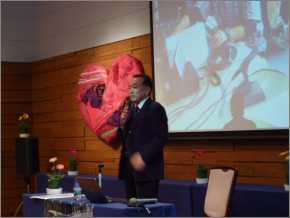
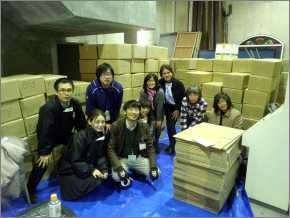
Mr. Sato lived in an area which was not affected by the tsunami, but he immediately arranged to secure fuel through the business connections of his company. He personally delivered support goods from the city received on March 16th to the affected areas. The first place he delivered was Kesennuma which was in a disastrous situation, and he went there 125 times to deliver the goods.
Oshu International Relations Association provided information in three languages through FM community broadcast, and it was received with gratitude since it reached the usually out-of-service area such as Ofunato and Rikuzentakata.
It seems that the removal of the affected buildings and ships of the area is being considered for psychological reasons, but he said that if people wish the memories of the disaster to be linked to the safety of the next generation, then those hurtful things are specifically the ones which need to be preserved.
The Konjikidō Golden Hall of Chūson-ji Temple built in 1124 is a compilation of the technology at the time and the pride of the people. Similarly, the latitude observatory built in Mizusawa in 1899 also strengthened the pride in the local residents that the only one thing in the world is in Mizusawa. It is said that the people involved in this observatory were the ones who introduced piano, violin, and tennis in this area.
Like these two, ILC could also become the pride of the area, stimulate children's interest in science, and continue to be the pride of the homeland into the future. It would also provide job opportunities to the 500 international residents living in Oshu City.
Mr. Sato said that the affected area is trying to forget the disaster, but he does not wish the others to forget. He also asked to purchase products from Miyagi, Iwate, and Fukushima, and not only that but to visit the affected area, as this visit in itself would become a volunteering activity.
● Lecture 7: Mr. Bill Lewis, International ILC Support Committee
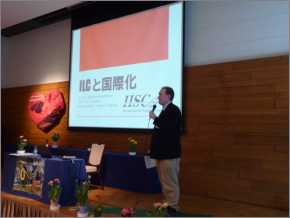
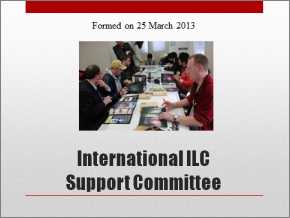
The International ILC Support Committee is comprised of 12 international residents (7 countries) living in Iwate. They cooperate with Oshu International Relations Association to present the needs of the international researchers, engineers, and their families to the government, private organizations and companies. The committee members, including Mr. Lewis, are providing knowledge and support to the city utilizing their abundant experience living as a foreigner in Iwate, in order to present the loving hospitality of the Oshu community they have experienced to those coming to Oshu City for ILC.
The International ILC Support Committee made the following proposal to Oshu City.
- Community / Social Integration: joining traditional events (festivals)
- Shopping: not enough options for large-sized people
- Transportation: roads are too narrow; request shuttle bus since the stations of Mizusawa and Mizusawa-esashi is far apart
- Living in Iwate: need more English signs
- Education: need to build international school
This proposal will not only benefit the international residents but Japanese as well.
There are many more ideas other than those proposed, and it was reported that they are being dealt with one by one. It was explained that the Oshu International Relations Association was not established for the international residents coming to Japan, but for the Japanese to assist in sharing information with the international residents in a better way.
● Lecture 8: Mr. Mitsuru Hatakeyama, Director, Okago Christian Resource Center
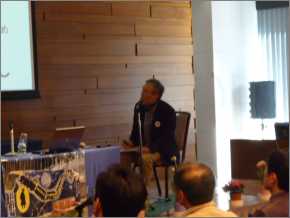
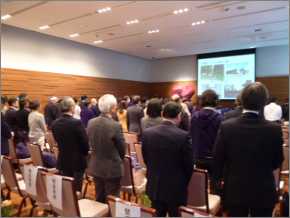
Mr. Hatakeyama spoke of the village in the suburbs of Tohoku where many people were martyred in the early Edo Period due to the suppression of Christians by the government. Stories and the sites of hidden Christians are scattered among the mountains, and he said that he wished to bring these sites together as a means to vitalize the area.
Okago District in Fujisawa-cho, Ichinoseki City, the southernmost area of Iwate, was the top iron-producing district of Sendai Domain where the entire village prospered with tatara iron making and Christianity in the early Edo Period. However, since 1639 the government suppressed Christians for several years, and more than 300 people from this single village were martyred (executed).
Praying caves and execution sites, where those who refused to step on a picture of Christ were ruthlessly executed, are scattered in remote areas in the mountains. In order to pass down this history to the future generations, Okago Christian Martyrdom Memorial Park was built between 1994 and 1995. The park includes a Christian Resource Center, the 309 steps to martyrdom where you can see Okago from the top level, a historical hill, and Okago Christian Martyrdom Memorial Kurusu Museum. There are also life-sized statues of Christ by Mr. Yasutake Funakoshi, a sculptor known also as one of the 26 saints of Nagasaki. Many pilgrims, historians, welfare participants, and educators now visit the park.
Tatara iron making began in Okago because there was an abundance of good-quality coals, and even today, the instant you step into Okago area you can still see charcoal making with smokes coming up. There are no temples in Okago but one Catholic church. The local residents set up "Okago Christian Historical Sites Local Revitalizing Committee" and Mr. Hatakeyama became the Director, so that this history would vitalize the area and the visitors could go see the Memorial Park and the village, walk through the woods and feel the history, and be moved by the pure souls of those who were martyred.
Our Foundation became acquainted with Mr. Hatakeyama in December 2012 through a priest in Fujisawa-cho with whom we have a good relationship with, and our Representative Director was deeply moved by the history of the area which led to our assisting local revitalization activities. At the end of that year, a mass was held at Okago Catholic Church, the first in more than 30 years as the church was closed for a long time.
We put up illuminations outside the church, and it lighted up the area after many years and where it was experiencing a steady decline of population. People cheered when the candles were lit, and it received a lot of coverage on newspapers.
We paused for a silent tribute at 14:26 during Mr. Hatakeyama's lecture, the time when the earthquake hit three years ago on March 11th, and everyone prayed for the victims of the Great East Japan Earthquake.
● Panel Discussion
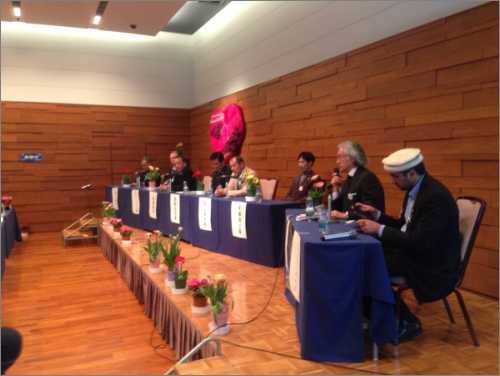
The panelists were Mr. Yoshihiro Kanno, Mr. Junji Suehiro, Mr. Ikuo Takeyama, Mr. Mitsuru Hatakeyama, Mr. Bill Lewis, Mr. Tsuyoshi Sato, and Tahir Sayed from our Foundation. Our Representative Director Sata was the coordinator, and it proceeded as an interactive discussion with the audience.
The discussion began by pointing out that for those who could not go to the affected areas, attending this symposium would constitute as one of the volunteering activities. It then touched on the subject of self-reliance, which has been the objective of the activities of Rentai Tohoku-Seinan since it was established. Our Representative spoke of how he believes "vitality" is important in self-reliance, that the earth is crucial in vitality and that it is important for the earth to regain vitality in order to be self-reliant, and that he has been acting all this time thinking that we may be able to support the victims regain their vitality by going and staying beside the victims.
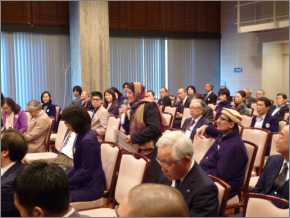
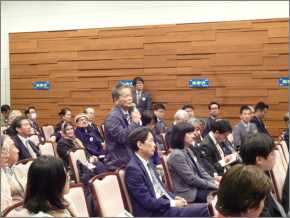
We received numerous comments from the audience and it seemed time was not enough: "I would like the valuable experiences of the lecturers to be published and be read by many", "I would like Tohoku to create a new Japan", "I appreciate having had the chance to hear about the affected areas", "There still is a lot more we should do", "The problems occurring in temporary housings such as the elders and the young not being able to become self-reliant is not just Tohoku's problem but is something occurring all over Japan", and "The right religious outlook has not been cultured in Japan due to the backlash from the history of anti-Christianity."
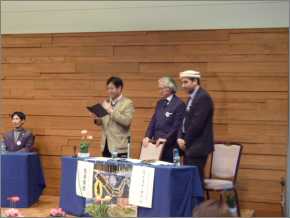
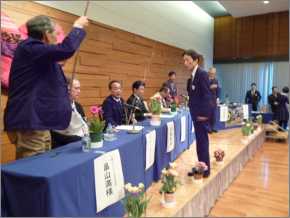
Mr. Ogata from the Rotary Club in Senmaya read aloud the poem "Amenimo makezu" by Kenji Miyazawa for the audience, in Iwate dialect. It has become difficult in recent years to hear true Tohoku dialect, and we believe the audience were able to feel close to Tohoku.
At the end of the symposium, Mr. Asada from the Japan Cherry Blossom Association kindly donated 3 cherry blossom trees.
We gave out the flower pots in the hall to the audience on their way out.
● Through the Symposium
People have began saying that "psychological support" is important in supporting Tohoku, but our Foundation has seen its necessity since it was established, and have continued our activities by changing the words to "self-reliance".
We feel it is extremely important for each and every Japanese to hold the right religious outlook and religious mind, but how is the current Japanese doing on this issue? When we try to assist through "psychological support", it seems we are being questioned on which religious outlook, r eligious mind or ethics are we basing our humanity in when we go and stay beside the affected areas (victims).
Categories:Staff reports
2014.03.12 20:31 admin











